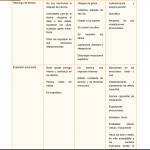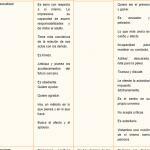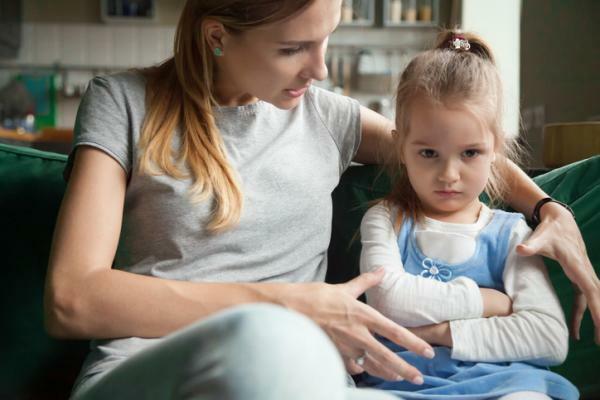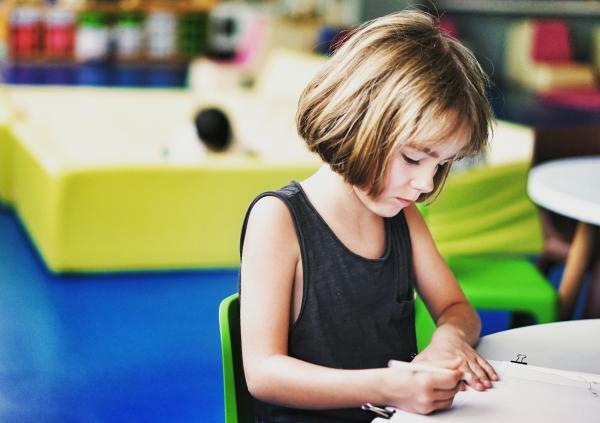
The Juan Ramón Jiménez Institute in Buenos Aires, Argentina asks me for psychological guidance on how to deal with situations of violence against children in a five-year-old ward and in the first year of EGB (Basic General Education), I suggest as a first intervention measure to hold a conference for parents and teachers on violence childish.
The purpose of the conference is to provide information about violence against children, to parents, teachers and administrators. The purpose of the same is to be able to transmit key concepts that allow them to reflect on the subject. Child violence is part or consequence of social violence, as far as it concerns us all. We will begin by defining the terms and explaining possible causes of violence, to end by giving some guidelines on how to act in the face of the problem.
Keep reading this PsychologyOnline article where we talk about a Conference on child violence: Parents and teachers for a culture of peace and non-violence
Index
- Actual society
- Stress
- Definition of violence
- Types of Violence
- Conflict
- Child Violence
- The development cycle
- Signs of Child Violence
- Issues on Child Violence
- New conception of conflict
- Attendee comments
Actual society.
To arrive at the features of today's society, we will review the characteristics of modernity. Modern man has faith in reason and in truth, which allows him to have an idea of progress and freedom. He is confident in the development of science, so he is hopeful for a better life for everyone.
Today our society is categorized as postmodern.
A clear example that illustrates its characteristics is that a writer when writing a text is not governed by pre-established rules, and cannot be judged by means of a decisive judgment by the application of that text. The writer works without rules and to establish the rules of what will have been done.
Philosophically postmodern, it is the denunciation and criticism of enlightened reason..
Postmodern traits:
-End of story: Jean Baudrillard posits that "deep down, you can't even talk about the end of the story, since it wouldn't have time to reach its own end"1
-Eason of nostalgia: you long for the hope and security that modern features conferred.
-Nihilism: supreme values lose validity. Denial of all belief, of all religious, political and social principles.
-Crisis of paradigms: scientific conceptions change.
-Pluralism.
-The liberation of rationalities and diversities.
-Hedonistic ethics: doctrine that proclaims pleasure, as the supreme end of life. Ethics lose their foundation: aesthetics are lived more than ethics.
-It lacks truths.
-Communication ecstasy
-Thought of suspicion: it reacts to the assumptions of modernity and a pessimistic skepticism flourishes that doubts everything.
The family and the current school do not escape this reality. So in both there is a crisis of values and authority and a tendency towards permissive education without clear limits. Postmodern thought doubts "the belief in a stable structure of being that governs becoming and gives meaning to knowledge and rules of conduct".2
Another outstanding feature of our current society is the speed with which events happen and the imperative need to register in them so as not to cease to belong or to be.
We live in a hurry, stressed and worried. Time is short and the events are so many. We receive much more stimulation than our grandparents but the time we have to make decisions is the same
Therefore, the current family has characteristics of its own to the social moment to which it belongs. We have little time to spend as a family, to talk, to reflect, to tell each other that we love each other, to congratulate ourselves on what has been achieved, etc. Here each of you will know what to aim for with respect to yourselves and your family. This may be considered problematic, but it is not in itself. The problem is not in quantity but in quality. In other words, the important thing is not how much time we spend with our children and spouses, but how we spend it, how we experience those moments, and what records are left in us adults and in our children of they.
The high level of stimulation and our different roles to develop, added to personality traits and the experiential history of each one of us, lead us to the theme of stress.
Stress.
Today we are permanently before different stimuli that we must interpret and before which we must act. Stress is the set of physiological reactions that prepare the body for action. So they have already concluded that this "set of physiological reactions that prepare us to act", stress, is activated many times in a person's day.
Our biology has not evolved at the rate of technological progress. The physiological responses that our body triggers today are the same ones that primitive man triggered. But as you imagine, because you live it, the difference is in the action. Primitive man could fight or flee when attacked by an animal. The same neuroendocrine-vegetative changes occur in us, but with an inhibition or socialization of the aggressive response. Visceral organs (cardiovascular, gastrointestinal, respiratory, etc. ) end effectors of sympathetic activation, are accusing their impact, as an adequate motor discharge of the musculoskeletal system does not occur. This occurs when the demands of the psychosocial environment are excessive, intense or prolonged, overcoming the body's capacity for resistance and adaptation, and leading to Distrust or bad stress. It occurs when the inflection point of the human performance curve is reached, which is increasing first, then it flattens out and finally begins its decline. The shape is an inverted U shape, illustrating how biological performance is optimized as activation increases, to a point that an excessive demand that leads to an excessive increase in the behavioral and biological response, places the organism on the verge of failure adaptive. From this point on, any additional stimulus, however small, can cause dysfunctions and diseases.
The numbers in the graph are to illustrate the concepts
By observing the graph we can visualize how our biological activation varies at different stress levels. Anxiety is normal, in the period of healthy tension, from the moment of fatigue, until collapse we enter distress, but from the exhaustion one reaches the pathological anxiety from which the disorders of anxiety.
Stress mechanisms are present from birth to death; therefore, both adults and children suffer its unfavorable consequences.
This picture produces mood variations: irritability and moodiness, negative interpretations of events and therefore a greater probability of a violent trigger in the behavior.
The modern man under the effects of social tension and his anxiety to adapt to the environment, is more prone to not being able to control his impulses, leading the aggression into violence.
The neurobiological bases of aggressiveness are found in the prefrontal cortex and in the amygdala of the brain. The brain areas that regulate aggressive behaviors are the same that regulate emotions. Our emotions depend on our thinking.
By restructuring thoughts, we can bind emotions by inhibiting aggression.

Definition of violence.
A violent situation is a terrible experience in which important interests are involved and where anxiety is predominant. Violence is the quickest solution.
The definition of violent in the dictionary of the Royal Spanish Academy says:
1-That it is out of its natural state, situation or mode.
2-That works with impetus and strength.
3-Which is done abruptly with extraordinary impetus and intensity.
4-Apply to the rapturous and impetuous genius that is easily carried away by anger.
5-That it is executed against the regular way or out of reason and justice.
In today's social system there is a shared anxiety among parents, teachers and students. The fact that anxiety is probably the most common feeling today means that we must understand violence as the most common response to it, a defensive reaction. Initially it is a self-preservation instinct.
Anxiety invokes and develops behaviors whose purpose is security. As long as these behaviors respond to threatening stimuli that endanger physical integrity and our territory, it is aggression. If these same behaviors can be anticipated, they are controlled and there is a prior preparation for action, it is violence
Types of Violence.
Verbal violence:
-verbalizations in the form of insults.
-verbalizations that indicate a lack of respect for the rights of the other.
-verbalizations that indicate bad manners.
-negative interjections: voice that expresses some deep feeling such as annoyance, anger, anger, etc.
Physical violence:
-Gestures that indicate lack of respect for the rights of the other.
-Behaviors that indicate bad manners or disrespect.
-Physical abuse.
Of these types of violence it is necessary to differentiate between those directed at another and those that are self-directed.
From aggression to control or violence
"Biology makes us aggressive, but it is culture that makes us peaceful or violent."3
Violence occurs when we cannot put our feelings and emotions into words. It is the fruit of culture and education.
Conflict.
Relationship of such type in which both parties seek to obtain objectives that may be or appear to be incompatible for one of the parties. Conflict can also be the result of divergent expectations, misunderstandings or misunderstandings.
The conflict arises from the struggle or from trying to obtain incompatible objectives or interests, it carries in itself a component of high emotionality that can lead to aggressiveness when they fail in some measure, the mediating instruments with which to confront the same. Faced with a tension of interests, a conflict appears, so far it is not problematic because everything depends on the procedures and strategies used to get out of it. If bellicose procedures are used, aggressive episodes will appear, which can occur with violence if one of the opponents does not play honestly and abuses his power, fighting to destroy or harm the opponent, not to solve the affair. That is violence, the dishonest, arrogant, and opportunistic use of power over the other.
The conflict is part of human life and therefore of institutions; It has a component of aggressiveness, which when it does not have the appropriate channels leads to violence.
Child Violence.
Today's child is born into a violent society.
There are three influences that maintain and determine this social status:
-the changing patterns of family and community life.
-the fact that society has refined violence as normal and acceptable.
-easy access to weapons and drugs.
In the course of childhood development, aggression and violence tell us a lot about the stage in the child is, their emotions, their learning and their family environments and educational.
The development cycle.
Long before its birth the future being already possesses the stamp of its individuality. Every child is born with potentialities that are their own. Each child possesses an exclusive mode of growth determined by those potentialities and by the environmental destiny.
There are, however, certain basic traits and certain growth sequences that are typical of the human species.
The general course of development is analogous for males and females; but women mature somewhat faster and earlier.
Seven stages are described in it:
1-Stage of the embryo (0 to 8 weeks)
2- Stage of the fetus (8-40 weeks)
3-Childhood (from birth to two years)
4-Preschool age (2-5 years)
5-Childhood (5-12 years)
6-Adolescence (12-20 / 24 years old)
7-adult maturity
Every child is unique, but also a member of the human species; so there are growth series that are never or rarely skipped.
The structuring of behavior, the child's active system, is a living structure that is cleverly formed through the architecture of growth. As the active system matures it achieves the reconciliation and balance of a multitude of opposites. But the process is so intricate that growth cannot follow a straight line. It zigzags, highlighting one or another opposite function, but finally coordinating and modulating both. Growth gains are consolidated during periods of relative stability. There is a rhythmic tendency towards balance. Evolutionary trends tend to repeat themselves at ascending levels of organization, just as if the developmental cycle discovered a spiral path. It is a progressive spiral, but at one stage the child may present a remarkable resemblance to what it was in a previous stage.
Child violence
Why do children choose to violently resolve their conflicts?
Do they choose it, or is it the only way they think possible?
Do they choose it, or is it the only way they learned?
In some stages of his development the child is aggressive because he responds to psychological characteristics of that evolutionary moment and because it responds to stimuli (internal or external) that have triggered struggle.
If the child cannot reflect on her aggression, and there are no stable developmental moments in which progress can be seen in the modulation of her behavior, the child is violent.
Signs of Child Violence.
-Intense anger.
- Attacks of rage or tantrums.
-Extreme irritability.
-Extreme impulsiveness.
-Easily frustrated.
-Self-aggression.
-Have few friends, and be rejected by children for their behavior.
-Extremely active and reckless-
-Difficulties to pay attention and significant and repeated excessive movements in different areas and at different times.
Issues on Child Violence.
What should be done if the child shows violent behavior?
If some or both parents and an educator are concerned, the child should undergo a full evaluation by a mental health professional An effective and timely psychological treatment guarantees a better quality of life for the child and his or her family.
Treatment goals typically focus on: helping the child learn how to control her anger, express your frustration and anger appropriately, take responsibility for her actions, and accept her actions consequences. Additionally, family conflicts, school problems, and community issues must be addressed.
Can violent behavior in children be prevented?
Research studies show that most violent behavior can be reduced or prevent if the child's exposure to violence in the home, community and media is reduced or eliminated diffusion. It is clear that violence fosters violence
Violent behavior reduction strategies:
-In the moments of evolutionary stability We must act, both parents and educators, so that through our example, social skills and education in values, the child learns to manage their conflicts without violence. It is important to build behavior on good days, because there is more response on your part.
-Preventive methods: It is ideal for handling explosive behavior that is between five and a half and six. Most violent outbreaks come from everyday events, which can be avoided. Prevention would consist of acceding to the child's request, if possible; or suggesting the opposite of the desired behavior. Direct clashes of will between parents and children should be avoided, because they reject imposed tasks. Faced with pressure from an adult, he challenges verbally. In the face of punishment, the result can be more violence.
-Another resource is to use the Magic, which consists of counting out loud until he magically begins to behave well.
-If the child self-aggravates or breaks things in the environment, it will be necessary to cut these behaviors. First, distraction is tried, if it does not work, it is avoided to behave in this way by holding him by his arms, showing firmness without violence, neither verbal nor physical; and bathes him or his face gets wet. Then it is important in some children, to relax them, through caresses, soft music, with a lullaby. If possible, sleep a few hours. Only after a few hours is it possible to invite him to reflect on what happened. If the child has done any damage, it is important to repair the damage to it, if possible. If he is self-righteous, show him her injuries and teach him the importance of taking care of her body.
-Hold you accountable for your actions
-Reflection and dialogue, planned strategies to avoid a next violent irruption.
-Set clear boundaries, both in the family and at school, define what can and cannot be done, what is good and what is bad.
-Define what authority is, and who represents her at home and at school.
-Reflect what authority is for.
-Coherence between parents, that one parent does not overrule the other in the presence of the child.
-Concordance between home and school discipline.
We can choose how to behave, if we think before acting about how we are going to communicate and the consequences of our actions.
Children must learn alternatives in conflict resolution.
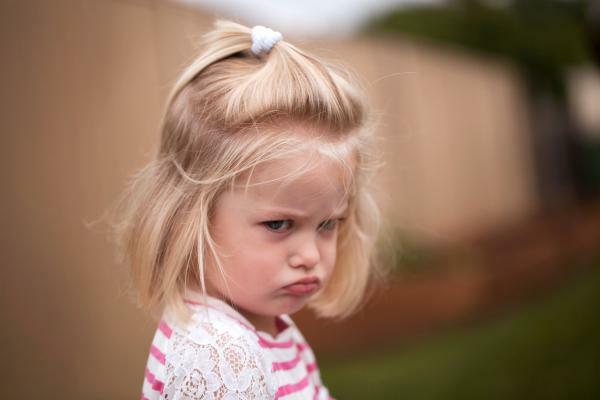
New conception of conflict.
The conflict is inherent to the human being, and we should not associate it with violence.
A new way of conceiving it is to enter it as part of life due to the differences in ideas that human beings have. See it as the possibility that men have to individualize ourselves, since from individualization, man can have different ideas from another man. Understood in this way, it is possible to face it successfully, because we understand the cause of it and we know that we can choose how to manage it.
Education in values
Each of us knows that things are important to us; This is because we have a personal and own table of values, which is made up of three main sources:
- what is current in society in which one lives and that one sees as normal
- it received through learning and education, both in educational institutions and in the family.
- it discovered through personal experience
In that table everything is not equally important; values have a hierarchy. Some are higher, and are nailed in the depths of the person, and others are lower and peripheral, they affect us less, because they are on the surface of personal life. According to our table of values, we distribute reality according to how we care more or less, and consequently we pay more or less attention to things when acting.
The interesting thing is to wonder what are the values by which each one is governed, what is its own table, and what hierarchy does it have.
Values are previous criteria that guide our action. For them we choose the end of our behavior and we choose the means to develop it.
During childhood we develop most of the values that will accompany us throughout our lives, hence the importance of that as parents and educators we transmit, based on our example and reflection, the values that allow us to reach a world of peace.
In order to go through our lives choosing our behaviors and specifying our purposes, we must have an internal guide of why, for what and how to act.
Let's begin to reflect with ourselves and with our children and students about some words that if we all internalize, there is no doubt that we will be happier:
- PEACE
- SOLIDARITY
- COOPERATION
- TOLERANCE
- ACCEPTANCE OF DIVERSITY
Postmodern humanity urges new values "ideals and common conceptions" and this new ethic must trace an ecumenical path that begins by establishing peace. The elements of peace are Harmony, Freedom and Justice.
We must build a culture of peace that summarizes the values of an authentic humanism in which the passion and reason of man harmonize.
Being parents and teachers is in us the possibility of forming values in the child, to give them the indispensable tools with which to develop as a new man who idealizes a new ethic in which new traits can be outlined social.

Comments from the attendees.
"It would be good if we all make it, for the good of humanity"
Adela de Iglesias
"It would be interesting to do workshops or dramatizations where we can experience the situations to which we referred. There is an untreated point, how parents react to these situations of violence at school, how we unintentionally provoke reactions in our children, etc. "
Esther Suarez
"What I most want is to be able to make all the expectations raised come true, putting them into practice and thus helping my children and perhaps it is a way to help others as well."
Beatriz Chavez
"It would be very interesting a conference for all the personnel that works in the institution, be it assistants, teachers of the three levels, directors, etc. "How to control or avoid overflows"
Liliana E. Stefanini
EGB Director
"It seemed very punctual and useful to me to be able to grow on a personal level more in knowledge and provide the children with a better quality of life every day."
Miss Andrea
"Although my children are not violent, everything I have heard strengthens me more in my scale of values and it was very useful and surely I will be more prepared for future situations, whether personal or to help other. Thanks!
Gimena D.'s mother Delalo
"I feel very gratified to have professionals like you. Thanks for your help."
Anny
"The conference allows me to reflect on how adults (parents) behave towards children, sometimes daily emergencies, take us away from what is really important, and in some way from the model we should be for Boys."
Liliana Lopez
"I thought the conference was very good, it was very useful and with great integration of topics. He clarified my doubts and gave me guidelines to improve the quality of life inside and outside of school. "
Carolina Bazan
"May we all be able to be that man of new ethics, both as parents and teachers. For María Paz Jazmín Frontini like all of hers.
Mother of Ma. Paz Jasmine Frontini
"It is always good to learn about our children. Thanks"
Fernando Ferri
"I would like that after this informative conference, we can do something more participatory, to be able to express all those things that occurred to us now and perhaps we could not consult them. I am not referring to individual cases. "
Adriana Barroso. Juan Cruz Ferri's mother
"It would be interesting to repeat this type of talks so that parents can" learn "about each stage in the lives of our children."
Flia. Hoinacki
"I would love to know how I teach you not to react with violence to an act of a colleague that" Lautaro considers violent "
Sandra Vote. Lautaro Reggina's mother
"I would be interested in being able to expand information and if it is possible to carry out conversations with groups of children within the school."
Liliana. Nicolás Barros's mother
"I feel that I lack guidance on how to help him digest the aggression or violence that is experienced in society and that goes from adults to children: assaults, robberies of children, abuse. Thanks!
Ma. Cristina Zulue

This article is merely informative, in Psychology-Online we do not have the power to make a diagnosis or recommend a treatment. We invite you to go to a psychologist to treat your particular case.
If you want to read more articles similar to Conference on child violence: Parents and teachers for a culture of peace and non-violence, we recommend that you enter our category of Emotional and behavioral disorders.
References
1 Baudrillard, Jean. The illusion of the end. The strike of events. Barcelona, Anagramaa, 1993. p. 14
2 G. Vattimo, "Metaphysics, violence and secularization" in the secularization of philosophy, Hermeneutics and Postmodernity, Gedisa, Barcelona, 1992, p.64
3Antón, Pedro: Violent behaviors do not have a biological but a cultural origin "Diario Médico 04-23-01
Bibliography
- Angulo Parra, Yolanda, "The essence of glass: Modernity and Postmodernity" México, D. F., 1997
- Erwin, Silva, "Ethics, Postmodernity and Globalization", UCA of Managua, Nicaragua, December 1996.
- Cía, Alfredo: "Anxiety, Stress, Panic and Phobias", Estudio Sigma, Argentina. 1994.
- Gesell, Arnold, Igg, Frances and Bates Ames, Louise: "The boy from five to ten years old", Ed. Piados, Barcelona, 1998.
- David, Johnson and Roger Johnson: "How to reduce violence in schools" Piados Educador, Argentina, 1999.
- Gauthy, Pierri: "Educating in the values for the societies of the year 2000" Madrid 1983.
- "European Conference on Initiatives to Combat Bullying in Schools" Seminars.
- Ghiso C. Alfredo: "Clues to deconstruct myths and develop proposals for school coexistence." Medellín, July 1998.
- "Manifesto 2000 for a culture of peace and non-violence and school mediation" Published in "El Diario" 9-10-2000.
- "Proposals to work in the classroom" ELCaME Diario Norte, Suplemento Escolar, 22-4-00.
- "Self-evaluation and conflict management" ELCaME Diario Norte, Suplemento Escolar, 12-5-00
- "Campaign against school violence" La Nación Line 1-6-99.
- D. Isaac, "The education of human virtues", Eunsa, Pamplona 1996
- "Peace is also learned" Diario La Capital, 5-5-96.
- "Child aggression" La Nación Digital 1998.
- "Experience of peaceful conflict resolution in a primary education center in Olot, Garrotxa region (Spain) 1998-1999.
Photos of Conference on child violence: Parents and teachers for a culture of peace and non-violence

